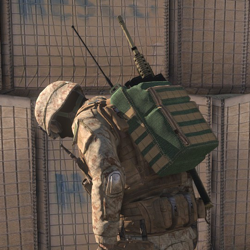Radio
Overview
 Clear communications are key to good teamwork, and good teamwork leads to a successful operation. This section deals with the use of shortwave and longwave radios, the purpose of each radio channel, useful settings, and the terminology that you need to be familiar with for radio communications.
Clear communications are key to good teamwork, and good teamwork leads to a successful operation. This section deals with the use of shortwave and longwave radios, the purpose of each radio channel, useful settings, and the terminology that you need to be familiar with for radio communications.
Shortwave Radio
The shortwave, or short range radio is the primary means of communication within a Squad and the radio that will be utilized the most. There are two types of shortwave radio: Programmable and Rifleman.
Squad Leaders, Corpsmen and other specialist roles will be equipped with programmable radios such as the AN/PRC-148 and AN/PRC-152 for communications at a Platoon level. These radios have a range of 5-8km and operate on a set of 100 pre-programmed channels that are compatible with the AN/PRC117F longwave radio.
Squad Leaders, and squad members will be equipped with a basic squad radio such as the AN/PRC343 for communications at a squad level. These radios have a very limited range of around 850m and operate on 16 blocks with 16 channels per-block. They are not frequency compatible with any other radio devices.
In the event that a Squad Leader dies or is incapacitated for a prolonged period of time, it is important that whoever assumes command of their unit retrieves their radio as quickly as possible.
Longwave Radio
The longwave, or long range radio is used by a Platoon Leader, Logistics Sergeant or Forward Air Controller to ensure consistently clear communications over larger distances. These roles will all be equipped with the AN/PRC117F backpack radio, which operates on the same 100 pre-programmed channels as the AN/PRC148 and AN/PRC152. It has an effectively unlimited range as it can reach the horizon without obstacles.
Anyone operating on a longwave radio device is held to a higher standard and is expected to use and enforce Radio Terminology on a consistent basis.
Channels
Each radio has a number of pre-programmed radio channels which are assigned to elements and radios according to their position in the Platoon Structure. The availability of channels and inter-operability between devices depends on the devices in use. The AN/PRC148, AN/PRC152 and AN/PRC117F radios each have 100 pre-programmed channels and are fully inter-operable. The AN/PRC343 radio issued to Squads operates on a different frequency spectrum and supports up to 16 blocks with 16 channels per-block.
Comm Card
The Comm Card is a valuable visual tool for finding and setting radio frequencies for a given element. The in-game CommCard is dynamically updated list that shows which elements are in the field and their expected radio frequencies.
Stereo Settings
The stereo settings on a radio allow the user to choose which ear they hear communications in from a particular radio device. For example, the Shortwave Radio can be set to operate in the left ear and the Longwave Radio set to operate in the right ear.
This feature can be particularly useful when operating more than one radio channel or device, as is the case with Squad Leaders by setting one radio to operate in the left ear, and one in the right ear, the Squad Leader always knows which channel they are hearing communication on and therefore, which channel to reply on.
Terminology
Radio terminology is a set of protocols put in place to ensure the clarity of radio communications while experiencing certain conditions such as background noise or technical issues, such as interference. By using specific words and phrases, communications can be kept clear and concise making it much easier to understand in difficult situations.
Please see the appendix on Radio Terminology for a reference list of terms and protocols, and their respective meanings.
Training Video
Our YouTube channel features a training video on how to use radio devices.
